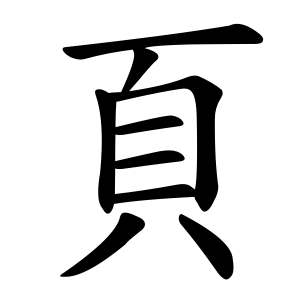頁
- page;
- head;
It represents the concept of a head or sometimes a person in classical usage.
In modern Chinese, Japanese, and Korean, the character is now almost exclusively used in the context of pages in a book or similar meanings.
Etymology
According to the Shuowen Jiezi (説文解字 shuōwén jiězì), 頁 (혈) is a compound ideograph made from the combination of 𦣻 (an early form representing the head or skull) and 儿 (which can represent a human figure).
Originally, the character was read 혈 in Korean Sino-pronunciation and solely meant “head.”
However, over time, as the character 葉 (엽, meaning "leaf") was used to indicate pages or sections in a book, and since 頁 had a similar pronunciation, it gradually took on that usage.
Thus, the meaning of 頁 expanded beyond “head” to also include: “page”, “section of a book”, “thin items like paper”.
The original meaning “head” is mostly preserved only when 頁 is used as a radical or component in other characters.
Usage in Korean
As a semantic radical, it conveys meanings related to the head or things associated with the head (such as facial features, expressions, or thought).
Characters with 頁
- 一月山金 (MBUC)
- ⿱ 丆 貝
- ⿳ 一 自 八
